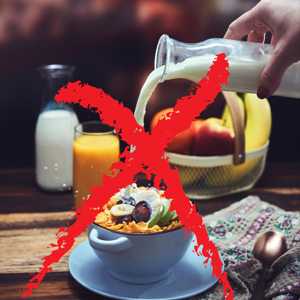Health: Viruddha Ahara: Ayurvedic Wisdom on Incompatible Foods

Mango lassi. Banana split. Strawberry milkshake. Or a summer salad of watermelon sprinkled with feta cheese. These are classics, so what could possibly be wrong with them? According to Ayurveda, they all are made from ingredients that are incompatible, and therefore harmful to health.
We all know that food is at the center of all desi gatherings—from a small backyard social to large weddings. Chaat is frequently mixed with tandoori chicken, or spinach raita with biryani. Fresh naans from the oven are wrapped around paneer tikkas and grilled mushrooms. Alternating between the spicy curries and mango lassi, families discuss the dinner menu as lunch gets served.
At every function, someone falls sick. We can blame the weather or the lack of chef’s culinary skills or exhaustion... but the real problem is hedonism and the inability to practice pratyahara (withdrawal of senses). It’s no surprise that there is a plethora of dietary medications available over the counter. So many desi aunties carry saunf (fennel seeds), laung (cloves), and chhoti elaichi (green cardamom) in their handbags. I have known people who travel with Eno or Pepto-Bismol.
In America, summer is all about gluttony and c’est la vie. Then starting from Thanksgiving through to the New Year, people make room for mindless eating and alcoholic indulgences in the name of “holiday season.” When you think about it, your gut needs a holiday from being overstuffed. So many of us set New Year intentions for a dry January, a vegan February, and a sugar-free March. But when you look closely, you see most people going through a yo-yo pattern between over-indulgence and deprivation even as they navigate digestive disorders.
From the Ayurvedic lens, food and eating seem more balanced and sustainable. This 5,000-year-old ancient healing science from India offers a logical approach for determining the correct diet based on an individual’s doshas and their imbalances. Food isn’t labeled good or bad. It’s all about what works best for you in the now.
Ayurveda will tell you that it’s not what we eat but what we digest that matters most. What and how we digest largely depends on an individual’s agni (digestive fire). The root cause of most diseases and conditions today stems from a weak agni and build-up of ama (endogenous toxins).
Amongst the major causes of toxins, bad food combinations or viruddha ahara rules the list. That’s why food combinations matter so greatly.
Dr. Vasant Lad, a preeminent practitioner and educator of Ayurveda, says, “When two or more foods having different tastes, energies, and post-digestive effects are combined, agni can become overloaded, inhibiting the enzyme system and resulting in the production of toxins. Yet these same foods, if eaten separately, might well stimulate agni, be digested more quickly, and even help to burn ama.”
Ayurvedic perspective is that each food has its own taste (rasa), a heating or cooling energy (virya), and a post-digestive effect (vipaka). Some foods also have an unexplained effect, which is called prabhava. Incompatible food combinations can have a negative effect on both the digestive system and the body as a whole. Poor combinations can cause nausea, indigestion, bloating, gas formation, fermentation, and can eventually lead to disease. It can have an adverse effect on the digestive system, endocrine system, nervous system as well as immune system.
According to Dr. Velhal Amol’s article, “A Critical Review on Incompatible Food Mentioned in Ayurveda” in the International Journal of Food and Nutritional Sciences, “Food incompatibilities lead to oxidative stress. Increased oxidative stress also results in dysregulation of various cellular processes through modulation of signaling molecules, production of antioxidant enzymes and non-enzymes, cell growth, and chronic inflammation, which play major roles in the incidence of chronic diseases such as cancer.”
Example 1: My dad loved banana split. Every time he visited us, we treated him to banana split; but I would let him know beforehand that he might experience discomfort. In the post-digestive effect, bananas are sour and milk is sweet. Although they both have a sweet taste and are cooling in energy, when we mix them together, despite their cooling energy and sweet taste, it confuses our digestive system and diminishes agni. My dad would invariably wake up congested or sometimes even get allergies after his banana split indulgence.
Example 2: Combining fruit and yogurt in a smoothie or parfait or milkshake has become a “healthy breakfast” option in many homes. I used to be a parfait junkie in my twenties. Even though a smoothie, a parfait, or even the super popular and ubiquitous mango lassi are all delicious indulgences, they will wreak havoc on your gut and digestive fire. Ayurveda will tell you that fruits and dairy shouldn’t be mixed. Fruits should be eaten alone 30 minutes prior to a meal or two hours after the meal. This is to avoid any fermentation in the stomach.
Example 3: One of the popular summer BBQ side dishes is watermelon salad with feta cheese and sprinkled springs of mint. For those of us who are mainly plant-based eaters, at a barbeque, the watermelon salad sounds heavenly. But, according to Ayurveda, watermelon should be eaten alone, in moderation, and before 5 pm because it’s guru (heavy) to digest. It shouldn’t be mixed with other fruits, let alone cheese. Watermelon has a sweet taste. Cheese, on the other hand, tastes predominantly sour, is almost always heat-producing, and usually has a sour post-digestive effect. When two foods that have different tastes, energies, and post-digestive effects are combined, it can overburden the digestive fire.
Examples of incompatible /antagonistic food combinations (Viruddha Ahara)
(Credit: National Library of Medicine)
- Veerya Viruddha (potency incompatibility) — fish + milk.
- Sanskar Viruddha (processing incompatibility) — heated honey.
- Matra Viruddha (dose incompatibility) — honey + cow’s ghee mixed in equal proportion.
- Krama Viruddha (order incompatibility) — hot water after taking honey.
- Kala Viruddha (time incompatibility) — pungent substance in summer and cold substances in winter.
- Krama Viruddha (order incompatibility) — consuming curd at night. Taking Madhura Rasa food, Dravya at the end of meals, or Tikta and Katu Rasa Dravyas (food substances) at the starting of meals.
- Samyoga Viruddha (combination incompatibility) — fruit salad or milk + banana.
- Parihar Viruddha (contraindication incompatibility) — consuming cold water immediately after having hot tea or coffee.
I am sure many of you while reading this article are gasping or rolling your eyes! It’s a whole other way of eating and living. While food combinations are an integral part of Ayurvedic cooking, Ayurveda is all about leading a balanced and wholesome life. Sure, it is impossible to avoid bad food combinations all the time but beware of them as you navigate your food choices.
Those with weak agni react to incorrect food combinations right away. If your agni is strong, you might be able to tolerate poor food combinations in small amounts for a short period of time. But a lifetime of such food choices will eventually catch up with you with some chronic illness or another.
“Because we cannot scrub our inner body, we need to learn a few skills to help cleanse our tissues, organs, and mind. This is the art of Ayurveda.” ~ Sebastian Pole
Sweta Vikram, a graduate of Columbia University, is a mindfulness coach and Ayurveda practitioner.
Disclaimer: The content is purely informative and educational in nature and should not be construed as medical advice. The information is not intended for use in the diagnosis, treatment, cure, or prevention of any disease. Please use the content only in consultation with an appropriate certified medical or healthcare professional.
Enjoyed reading Khabar magazine? Subscribe to Khabar and get a full digital copy of this Indian-American community magazine.
blog comments powered by Disqus












